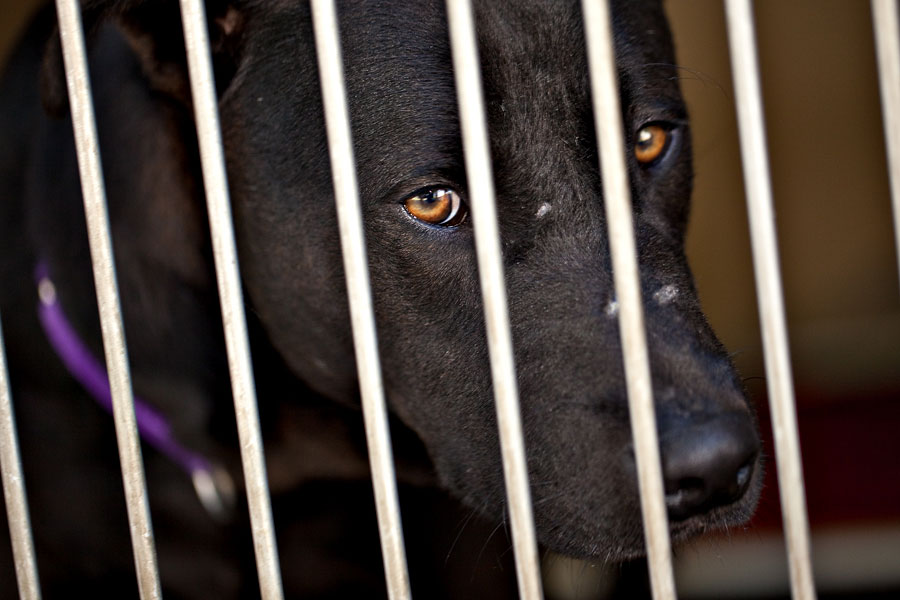Acts of cruelty to animals are not mere indications of a minor personality flaw in the abuser; they are symptomatic of a deep mental disturbance. Research in psychology and criminology shows that people who commit acts of cruelty to animals don’t stop there – many of them move on to their fellow humans. “Murderers … very often start out by killing and torturing animals as kids,” says Robert K. Ressler, who developed profiles of serial killers for the Federal Bureau of Investigation (FBI).(1)
Studies have shown that violent and aggressive criminals are more likely to have abused animals as children than criminals who are considered non-aggressive.(2) A survey of psychiatric patients who had repeatedly tortured dogs and cats found that all of them had high levels of aggression toward people as well.(3) According to a New South Wales newspaper, a police study in Australia revealed that “100 percent of sexual homicide offenders examined had a history of animal cruelty.”(4) To researchers, a fascination with cruelty to animals is a red flag in the backgrounds of serial killers and rapists. According to the FBI’s Ressler, “These are the kids who never learned it’s wrong to poke out a puppy’s eyes.”(5)
Examples That Make the Headlines: Notorious Killers
History is replete with serial killers whose violent tendencies were first directed at animals. Albert DeSalvo (the “Boston Strangler”), who killed 13 women, trapped dogs and cats and shot arrows at them through boxes in his youth.(6) Serial killer Jeffrey Dahmer impaled frogs, cats, and dogs’ heads on sticks.(7) Dennis Rader (the BTK killer), who terrorized people in Kansas, wrote in a chronological account of his childhood that he hanged a dog and a cat.(8) During the trial of convicted sniper Lee Boyd Malvo, a psychology professor testified that the teenager, who killed 10 people with a rifle, had “pelted – and probably killed – numerous cats with marbles from a slingshot when he was about 14.”(9)
The deadly violence that has shattered schools in recent years has, in most cases, begun with cruelty to animals. High-school killers such as Kip Kinkel in Springfield, Oregon, and Luke Woodham, in Pearl, Mississippi, tortured animals before starting their shooting sprees.(10) Columbine High School students Eric Harris and Dylan Klebold, who shot and killed 12 classmates before turning their guns on themselves, spoke to their classmates about mutilating animals.(11)
“There is a common theme to all of the shootings of recent years,” says Dr. Harold S. Koplewicz, director of the Child Study Center at New York University. “You have a child who has symptoms of aggression toward his peers, an interest in fire, cruelty to animals, social isolation, and many warning signs that the school has ignored.”(12)
Sadly, many of these criminals’ childhood violence went unexamined – until it was directed at humans.
‘The Link’ Next Door: Cruelty to Animals and Family Violence
Because abusers target the powerless, crimes against animals, spouses, children, and the elderly often go hand in hand. Children who abuse animals may be repeating a lesson learned at home; like their parents, they are reacting to anger or frustration with violence. Their violence is directed at the only individual in the family who is more vulnerable than they are: an animal. Professor Frank R. Ascione of the University of Denver Graduate School of Social Work says, “The research is pretty clear that there are connections between animal abuse and domestic violence and child abuse.”(13)
Parents who neglect or abuse animals frequently subject their own children to similar hardships. Indiana residents Jade M. Jonas and Michael R. Smith faced felony charges after authorities reportedly discovered their two children as well as three dogs languishing in their filthy home. According to news sources, officials first found a tethered dog who was deprived of food and water outside the home. Upon entering the couple’s residence, investigators reportedly found a three month-old boy lying near piles of feces, trash, and rotten food. They also found a half-clothed toddler and two additional dogs.(14) In another case, Illinois authorities found 40 parasite-ridden dogs languishing amid six inches of feces on property occupied by John Morris. According to news reports, officials responding to neighbors’ concerns found the sick and emaciated dogs confined to filthy animal carriers before confirming that three children – ages 3, 10, and 15 – lived in the horrific conditions as well.(15)
Sixty percent of more than 50 New Jersey families that had received treatment as a result of incidents of child abuse also had animals in the home who had been abused.(16) In three separate studies, more than half of the battered women surveyed reported that their abuser threatened or injured their animal companions.(17) In one of those studies, one in four women said that she stayed with the batterer because she feared leaving the animal behind.(18)
Stephen Williams was charged with cruelty to animals, child cruelty, and aggravated assault in Georgia after allegedly hacking his wife’s puppy to death with an ax and threatening to decapitate her with the same weapon – all in front of three horrified children.(19) Scott Maust of Pennsylvania was charged with corruption of minors, making terroristic threats, and cruelty to animals after allegedly shooting his family’s dog with a .22-caliber firearm, ordering his four children to clean up the bloody scene, and threatening to kill them if they told anyone.(20)
Stopping the Cycle of Abuse
Schools, parents, communities, and courts are beginning to realize that shrugging off cruelty to animals as a “minor” crime is like ignoring a ticking time bomb. Some courts now aggressively penalize animal abusers, examine families for other signs of violence, and order perpetrators to undergo psychological evaluations and counseling.
In March 2006, Maine Governor John Baldacci signed a law – the first of its kind in the U.S. – that permits judges to include animal companions in court-issued protection orders against domestic abusers.(21) Other states, including Vermont, New York, California, and Colorado, followed suit. People who harm animals in violation of a court order can face fines and jail time.(22)
A handful of states require animal control officers and spousal/child abuse investigators to share information when animal abuse or domestic abuse is found in a home. Professor Ascione, who also advises law enforcement officials in abuse cases, told The New York Times that cross-reporting requirements have helped foster early intervention.(23)
What You Can Do
Communities must recognize that abuse to any living being is unacceptable and endangers everyone. Children should be taught to care for and respect animals. After an extensive study of the links between animal abuse and human abuse, two experts concluded, “The evolution of a more gentle and benign relationship in human society might be enhanced by our promotion of a more positive and nurturing ethic between children and animals.”(24)
With that in mind, please be sure to do the following:
- Urge your local law enforcement agencies, prosecutors, judges, and schools to take cruelty to animals seriously. Those charged with protecting our communities and animals must send a strong message that violence against any feeling creature – human or nonhuman – is unacceptable.
- Be aware of signs of neglect or abuse in children and animals, and immediately report suspected crimes to authorities. Take children seriously if they report that animals are being neglected or mistreated. Some children won’t talk about their own suffering but will talk about an animal’s suffering.
- Don’t ignore even minor acts of cruelty to animals by children. Talk to the child and the child’s parents. If necessary, call a social worker.
References
1) Daniel Goleman, “Experts See Parallels Between Dahmer, Previous Serial Killers,” New York Times News Service, 11 Aug. 1991.
2) Sara C. Haden and Angela Scarpa, “Childhood Animal Cruelty: A Review of Research, Assessment, and Therapeutic Issues,” The Forensic Examiner 14 (2005): 23-33.
3) lan R. Felthous, M.D., “Aggression Against Cats, Dogs, and People,” Child Psychology and Human Development 10 (1980): 169-77.
4) “Animal Cruelty; Common in Many Killers,” Sunbury/Macedon Ranges Leader, 26 Apr. 2005.
5) Ruth Larson, “Animal Cruelty May Be a Warning. Often Precedes Harm to Humans,” The Washington Times, 23 Jun. 1998.
6) Andrea Vance, “10-Year-Old Luke Kicked a Lamb to Death Like a Football,” News of the World (U.K.), 23 Jan. 2005.
7) Goleman.
8) Tim Potter, “BTK Describes His Own Crimes,” The Wichita Eagle, 16 Jul. 2005.
9) Paul Bradley and Kiran Krishnamurthy, “Right and Wrong ‘An Illusion’/Psychologist Who Met With Malvo Said Teen’s Disorder Limited His Moral Judgment,” Richmond Times Dispatch, 9 Dec. 2003.
10) Deborah Sharp, “Abuse Will Often Cross Species Lines,” USA Today, 28 Apr. 2000.
11) Mitchell Zuckoff, “Loners Drew Little Notice,” Boston Globe, 22 Apr. 1999.
12) Ethan Bronner, “Terror in Littleton: The Signs; Experts Urge Swift Action to Fight Depression, Isolation, and Aggression,” The New York Times, 22 Apr. 1999.
13) Ian Urbina, “Animal Abuse as Clue to Additional Cruelties,” The New York Times, 17 Mar. 2010.
14) “Police Remove Children From Filthy House,” Associated Press, 17 Jun. 2005.
15) John H. Croessman, “Filthy Find,” Du Quoin Evening Call, 8 Dec. 2004.
16) Elizabeth Deviney et al., “The Care of Pets Within Child Abusing Families,” International Journal for the Study of Animal Problems 4 (1983): 321-9.
17) David Crary, “Program Links Domestic Abuse, Pets,” Associated Press, 11 Mar. 2001.
18) Sharp.
19) “Man Accused of Killing Puppy With Ax as Children Begged Him to Stop,” Associated Press, 17 Nov. 2003.
20) “Man Charged With Threatening Children Over Dead Family Dog,” Associated Press, 28 Feb. 2004.
21) Sharon Kiley Mack, “Law Protects Pets of Abuse Victims,” Bangor Daily News, 1 Apr. 2006.
22) Phil Arkow, “Expanding Domestic Violence Protective Orders to Include Companion Animals,” American Bar Association Commission on Domestic Violence eNewsletter 8 (2007).
23) Urbina.
24) Stephen R. Kellert and Alan R. Felthous, “Childhood Cruelty Toward Animals Among Criminals and Noncriminals,” Human Relations 38 (1985): 1113-29.

